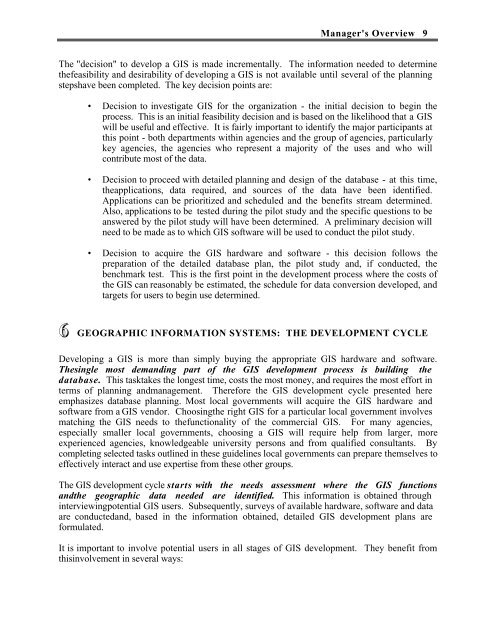Local Government GIS Demonstration Grant - NCGIA Buffalo
Local Government GIS Demonstration Grant - NCGIA Buffalo
Local Government GIS Demonstration Grant - NCGIA Buffalo
Create successful ePaper yourself
Turn your PDF publications into a flip-book with our unique Google optimized e-Paper software.
Manager's Overview 9<br />
The "decision" to develop a <strong>GIS</strong> is made incrementally. The information needed to determine<br />
thefeasibility and desirability of developing a <strong>GIS</strong> is not available until several of the planning<br />
stepshave been completed. The key decision points are:<br />
• Decision to investigate <strong>GIS</strong> for the organization - the initial decision to begin the<br />
process. This is an initial feasibility decision and is based on the likelihood that a <strong>GIS</strong><br />
will be useful and effective. It is fairly important to identify the major participants at<br />
this point - both departments within agencies and the group of agencies, particularly<br />
key agencies, the agencies who represent a majority of the uses and who will<br />
contribute most of the data.<br />
• Decision to proceed with detailed planning and design of the database - at this time,<br />
theapplications, data required, and sources of the data have been identified.<br />
Applications can be prioritized and scheduled and the benefits stream determined.<br />
Also, applications to be tested during the pilot study and the specific questions to be<br />
answered by the pilot study will have been determined. A preliminary decision will<br />
need to be made as to which <strong>GIS</strong> software will be used to conduct the pilot study.<br />
• Decision to acquire the <strong>GIS</strong> hardware and software - this decision follows the<br />
preparation of the detailed database plan, the pilot study and, if conducted, the<br />
benchmark test. This is the first point in the development process where the costs of<br />
the <strong>GIS</strong> can reasonably be estimated, the schedule for data conversion developed, and<br />
targets for users to begin use determined.<br />
6 GEOGRAPHIC INFORMATION SYSTEMS: THE DEVELOPMENT CYCLE<br />
Developing a <strong>GIS</strong> is more than simply buying the appropriate <strong>GIS</strong> hardware and software.<br />
Thesingle most demanding part of the <strong>GIS</strong> development process is building the<br />
database. This tasktakes the longest time, costs the most money, and requires the most effort in<br />
terms of planning andmanagement. Therefore the <strong>GIS</strong> development cycle presented here<br />
emphasizes database planning. Most local governments will acquire the <strong>GIS</strong> hardware and<br />
software from a <strong>GIS</strong> vendor. Choosingthe right <strong>GIS</strong> for a particular local government involves<br />
matching the <strong>GIS</strong> needs to thefunctionality of the commercial <strong>GIS</strong>. For many agencies,<br />
especially smaller local governments, choosing a <strong>GIS</strong> will require help from larger, more<br />
experienced agencies, knowledgeable university persons and from qualified consultants. By<br />
completing selected tasks outlined in these guidelines local governments can prepare themselves to<br />
effectively interact and use expertise from these other groups.<br />
The <strong>GIS</strong> development cycle starts with the needs assessment where the <strong>GIS</strong> functions<br />
andthe geographic data needed are identified. This information is obtained through<br />
interviewingpotential <strong>GIS</strong> users. Subsequently, surveys of available hardware, software and data<br />
are conductedand, based in the information obtained, detailed <strong>GIS</strong> development plans are<br />
formulated.<br />
It is important to involve potential users in all stages of <strong>GIS</strong> development. They benefit from<br />
thisinvolvement in several ways:




